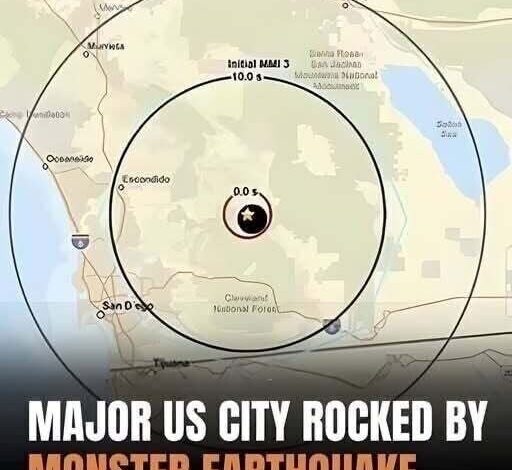A powerful 5.2-magnitude earthquake rattled Southern California late Monday night, shaking homes from San Diego County all the way up toward Los Angeles and jolting millions of people out of their late-night routines. The quake struck at 11:23 p.m. near Julian, a small mountain town east of San Diego, but the force of it rippled across the region with an intensity that caught many off guard.
For a few seconds, the world shifted. Windows rattled violently. Hanging lights swung like pendulums. Pets barked, car alarms blared, and residents felt their floors jump beneath them before the rolling motion settled in. It wasn’t long, but it was strong enough to make people freeze where they stood, wondering if this was the start of something bigger. Social media lit up instantly with the familiar mix of panic, humor, and relief that always follows a California quake.
Despite the jolt, officials confirmed there were no immediate reports of injuries or major structural damage — a stroke of luck, given how widely the shaking was felt. The San Diego County Sheriff’s Department and local fire agencies mobilized quickly, checking on infrastructure, bridges, and vulnerable areas. Power stayed on in most neighborhoods, though a few communities reported brief flickers and surges.
According to the U.S. Geological Survey, the quake hit at a shallow depth of about eight miles. Shallow quakes pack more punch at the surface, which explains the sharp, sudden shock many residents described. While this was nowhere near the level of a catastrophic event, seismologists say it was strong enough to serve as a wake-up call — a reminder that the ground in California never stays still for long.
One thing that stood out last night was the effectiveness of California’s ShakeAlert early-warning system. For many residents, their phones buzzed with a warning about five seconds before the shaking began. Five seconds isn’t much in everyday life — but in an earthquake, it’s enough time to step away from a window, brace yourself, duck under a table, or stop a train. It’s enough to save a life. Last night was one of the clearest demonstrations yet that the system works, and experts praised it as a crucial tool that could make a massive difference when the inevitable larger quake hits.
As the adrenaline faded, the region braced for aftershocks. So far, none have been significant, but seismologists warn that smaller tremors can still strike in the days ahead. Most aftershocks are harmless — just quick reminders that the earth is still settling — but authorities urge people not to ignore them.
In the hours after the shaking stopped, emergency officials repeated the same message: use this as a warning. Review your earthquake plan. Check your emergency kits. Secure the tall bookshelves you’ve been meaning to bolt down. Make sure you have water, flashlights, batteries, and medications stocked. Talk to your family about where to meet and how to communicate if a bigger quake hits. Moments like this are nature’s tap on the shoulder — a reminder that preparation matters more than fear.
Southern California sits along a web of fault lines tied to the Pacific Ring of Fire, one of the most seismically active regions on the planet. A 5.2 quake isn’t rare, but it’s strong enough to get people thinking. And that’s the point. Earthquakes don’t offer warnings. They hit when they want, reshape a moment, and leave you hoping you were ready.
Last night, Southern California got lucky. The shaking was widespread but not destructive. No collapsed freeways. No broken gas lines. No fires or mass outages. Just a few seconds of chaos and a long exhale afterward.
But if there’s one thing longtime residents know, it’s that you can’t rely on luck twice.
As people across the region settle back into routine, the memory of those few seconds remains sharp — the jolt that pulled them from sleep, the lights that swayed without warning, the quiet that followed. It’s a reminder of how fast everything can shift and how crucial it is to stay prepared. California will shake again. It always does. The question is never if, only when.
For now, the region is breathing a collective sigh of relief — but also hearing the message beneath the shaking: stay alert, stay ready, and don’t wait for the next tremor to get prepared.
